 Intel
Intel
The famous microprocessor and chipset manufacturer from the 1970s through to today, this page is dedicated to Intel's expansion cards. For information on their microprocessors, click here.
To jump directly to a section, click below:
Memory Expansion and Multi I/O Cards
Above Board
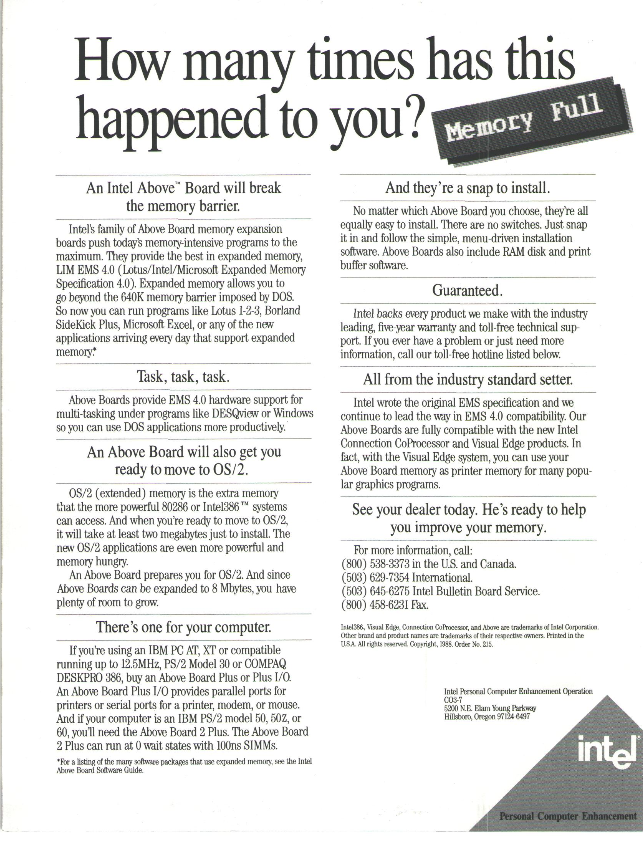
 Intel's Above Board series were memory expansion cards for the IBM PC through to the IBM PC/AT. The original Model 5150 IBM Personal Computer came with only 128 KB of main memory. As time moved forward, software applications began to outgrow this, so customers had the need for more memory to run their software.
Intel's Above Board series were memory expansion cards for the IBM PC through to the IBM PC/AT. The original Model 5150 IBM Personal Computer came with only 128 KB of main memory. As time moved forward, software applications began to outgrow this, so customers had the need for more memory to run their software.
During the early days of the IBM PC, a number of peripheral manufacturers started to produce memory expansion boards that used the AT bus and typically came in at a more competitive price point than IBM. Among the most popular were AST with the AST SixPack and SixPackPlus. Intel's response was the cleverly-titled "Above Board" range.
Conforming to the then-new Lotus/Intel/Microsoft Expanded Memory Specification (LIM EMS) which allowed PC/XT users to be able to break the 1 MB memory barrier, the cards could be used to expand convential memory from 512 KB up to 640 KB (they called this "backfill memory"), and the rest of the board's memory, if fitted, was then able to be used as either Extended Memory (XMS) or Expanded Memory (EMS). You could even configure the added memory to be a RAM disk.
Nearly all Above Boards had 3 connectors along the top edge into which a "Piggyback" daughterboard could be installed to further expand the memory the card offered.
They came with installation software that included a diagnostic utility to test the newly-installed RAM. One utility was called CHKMEM - this displayed the total RAM installed in your computer, broken down into conventional memory, extended memory and expanded memory.
Some Downloads for the Above Board Series:
Above Board Drivers and Utilities
Above Board Plus Drivers and Utilities (1989)
Above Board Plus 8 Drivers and Utilities (1990)
 Above Board Above Board
Year: 1984
Interface: 8-bit ISA
Initial Memory: 256 KB
Max. On-Board Memory: 2 MB
Price: $239 (Above Board PC 64KB, Jul 1987)
The original Intel Above Board was an 8-bit card, designed to expand the memory of the original IBM Model 5150 IBM PC. A set of DIP switches in the upper-right corner of the board (closest to the plate) are used to select the following:
SW1: Off = Board is populated with 64 Kbit DRAM chips.
SW1: On = Board is populated with 256 Kbit DRAM chips.
SW2-4: Off/On/On = Total installed memory is 256 KB
SW2-4: Off/On/Off = Total installed memory is 320 KB
SW2-4: Off/Off/On = Total installed memory is 384 KB
SW2-4: Off/Off/Off = Total installed memory is 448 KB
SW2-4: On/On/On = Total installed memory is 512 KB
SW2-4: On/On/Off = Total installed memory is 576 KB
SW2-4: On/Off/On = Total installed memory is 640 KB
SW5-SW8: On/On/On/On = Base I/O address is 208h & 209h
SW5-SW8: On/On/On/Off = Base I/O address is 218h & 219h
SW5-SW8: On/Off/On/Off = Base I/O address is 258h & 259h
SW5-SW8: On/Off/Off/On = Base I/O address is 268h & 269h
SW5-SW8: Off/On/Off/On = Base I/O address is 2A8h & 2A9h
SW5-SW8: Off/On/On/Off = Base I/O address is 2B8h & 2B9h
SW5-SW8: Off/Off/Off/On = Base I/O address is 2E8h & 2E9h
You cannot mix and match 64 Kbit and 256 Kbit chips on the board at all. All banks must have the same type of DRAM IC. Bank 0 (closest to the plate) must be populated in full first, followed by other banks to the left.
An "Above Board PS" was also released. This differed from the Above Board only in that it provided both a parallel and serial port in addition to the memory expansion.
AboveBoard/PC Installation & Utility Disk
|
 Above Board Plus 8 Above Board Plus 8
Year: 1989
Interface: 8-bit ISA
Price: $1,495 (2 MB RAM w/ serial & parallel port), $1,445 (2 MB RAM and no serial/parallel ports), $1,445 (6 MB piggyback with 2 MB RAM installed)
"14 Almost-Cheap Megs of EMS
Depending on your point of view, Intel Corp.'s new EMS board, the Above Board Plus 8, is either overpriced or a bargain. It's a bargain because it lets you use megabit DRAM chips to stuff 8MB of EMS RAM into a single slot. These chips are now the cheapest form of memory you can find., with prices plummeting below $125 per megabyte. With an optional piggybackcard, you can add 6 more economical MBs, while giving up half of an adjacent slot.
But the list price of the Above Board Plus 8, $1,495 with 2MB of RAM installed ($50 less if you don't want the serial
and parallel ports), seems to be based on last year's RAM prices of $500 per megabyte. The piggyback, at $1,445 with 2MB of RAM installed, is equally high priced, although all these prices are certain to drop before long.
In the PC Labs benchmark tests, the Intel board performed at the top of the scale in EMS memory reads, but because Intel doesn't use alternative hardware register sets in its implementation of the LIM 4.0 standard, the board was among the slowest we've seen at moving data in and out of EMS memory for DESQview- or Microsoft Windows-style
task switching. To its credit, its one of the few boards that perform flawlessly on the EMS compatibility test.
The Above Board Plus 8 normally uses one of the 16-bit slots of an AT or compatible, but it also works in an XT's 8-bit slot. As is usual with Intel boards, installation is just about effortless. Nevertheless, the Above Board Plus 8 comes with plenty of detailed help screens and a lucid manual. The board's finish and workmanship is fine enough to be called craftsmanship."
PC Magazine, August 1989
|
 Above Board MC Above Board MC
Year: 198?
Interface: MCA
|
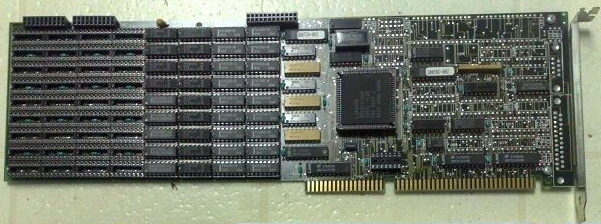 Above Board AT Above Board AT
Year: 198?
Interface: 16-bit ISA
Initial Memory: None?
Max. On-Board Memory: 2 MB
The Above Board AT has 4 banks which can support up to 512 KB per bank, giving a total expansion capability of 2 MB. In the image above, bank 0 is populated (closest to the bracket) so this is the "backfill" memory that brings the conventional memory of the PC from 512 KB up to 640 KB. Then banks 2 and 3 are populated, giving a further 1 MB of Extended or Expanded memory.
An "Above Board PS/AT" was also released. This differed from the Above Board AT only in that it provided both a parallel and serial port in addition to the memory expansion.
|
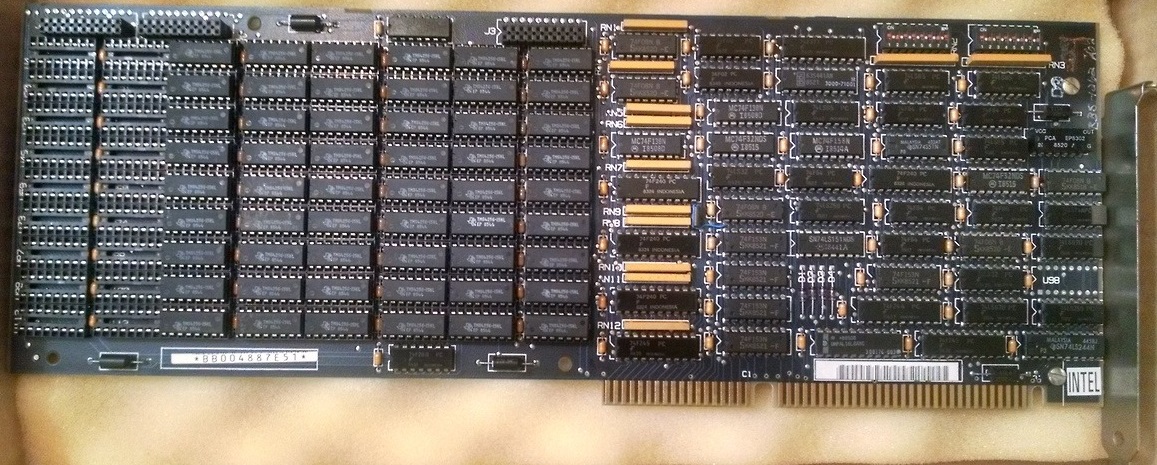 Above Board Plus (aka Above Board 286) Above Board Plus (aka Above Board 286)
Year: 198?
Interface: 16-bit ISA
Initial Memory: 256 KB
Max. On-Board Memory: 2 MB
Price: $349 (Above Board 286 512KB, Jul 1987)
Above Board Plus/286 has a selection switch that allows it to work in either an IBM PC/XT (8-bit ISA slot) or in a 286-based PC (16-bit ISA slot). To work in an IBM PC/XT you need to have a special chip installed - this was not included with the board itself.
The card has four banks of memory onboard, and supports 256 Kbit DRAM chips only (eighteen chips per bank). This gives it a capacity ranging from 512 KB with just one bank populated, up to 2 MB with all four banks populated. The board shown in the image above is populated with 256 Kbit chips with two banks populated so has 1 MB of RAM installed.
An Above Board PS/286 was also released. This differed from the Above Board 286 only in that it provided a parallel and serial port also. It tended to retail for $30 more than the standard Above Board 286.
|
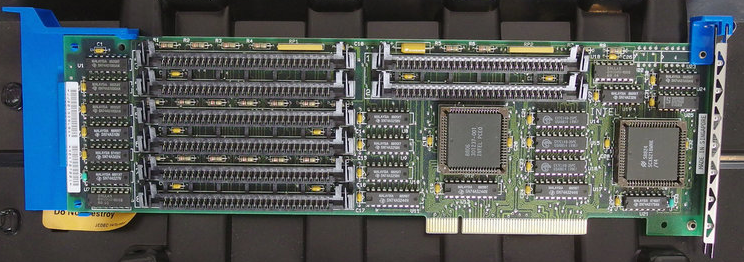 Above Board 2 Plus Above Board 2 Plus
Year: 1990?
Interface: MCA
Memory Types: 30-pin SIMM with parity
(256 Kbit or 1Mbit)
Initial Memory: None
Max. On-Board Memory: 8 MB
Model No.: PSMB5200
The Above Board 2 Plus was designed to expand the memory capabilities of the Micro-Channel Architecture-based IBM PS/2 Model 50 and 60. The card supported 8 SIMM slots, so you could installed eight 1 MB 30-pin SIMMs for a maximum of 8 MB expansion.
|
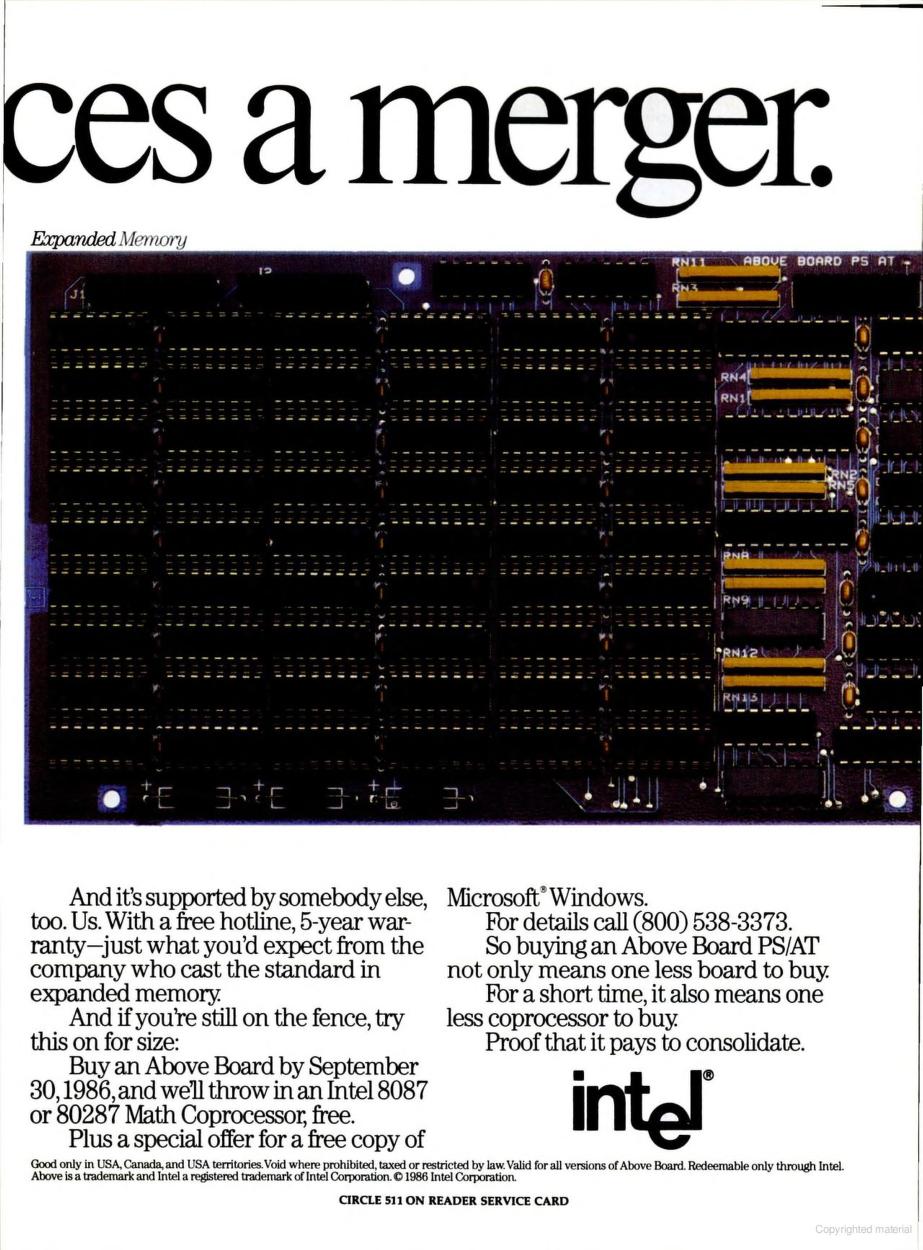 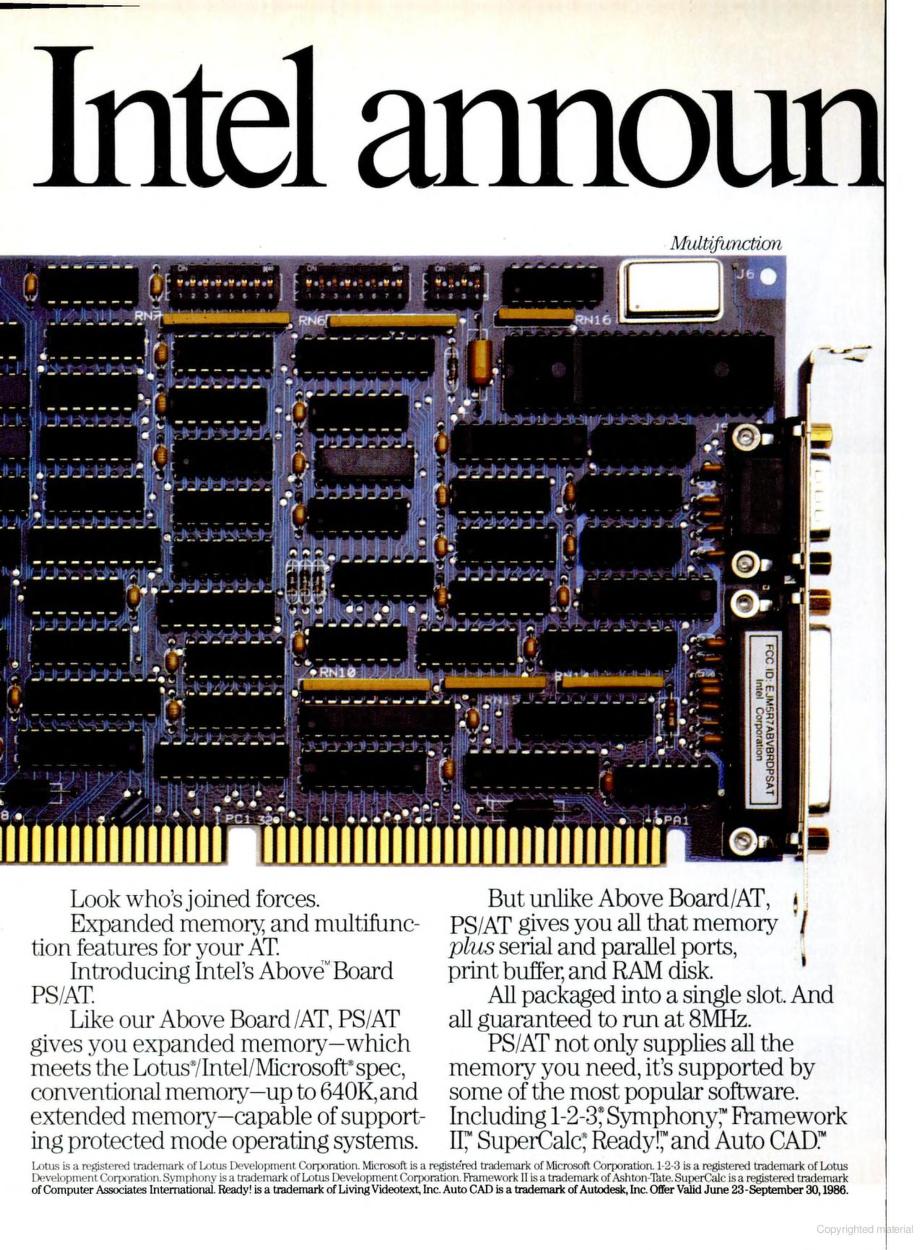 Above Board PS/AT Above Board PS/AT
Year: 1984
Interface: 16-bit ISA
Intel Part No.: 300526-001
|
Processor Upgrade Boards
INBoard
.jpg) At the time of the 80386's launch and for several years after, upgrading your PC was extremely expensive, since motherboards and CPUs weren't typically replaced by themselves as they are today - when a CPU upgrade was necessary, customers would purchase a whole new PC, possibly retaining any expansion cards they'd bought.
At the time of the 80386's launch and for several years after, upgrading your PC was extremely expensive, since motherboards and CPUs weren't typically replaced by themselves as they are today - when a CPU upgrade was necessary, customers would purchase a whole new PC, possibly retaining any expansion cards they'd bought.
Intel's Inboard range was their answer to prolonging the life of a PC with an entire upgrade PC-on-a-card. These days we refer to such boards as a "single board computer", as they really contain an entirely new motherboard and CPU on an expansion card.
Intel's Inboard actually didn't take over the parent motherboard fully. On power up, the parent board's BIOS would POST (Post On Self-Test), and only after it had loaded a .SYS device driver from config.sys would control be passed to the Inboard.
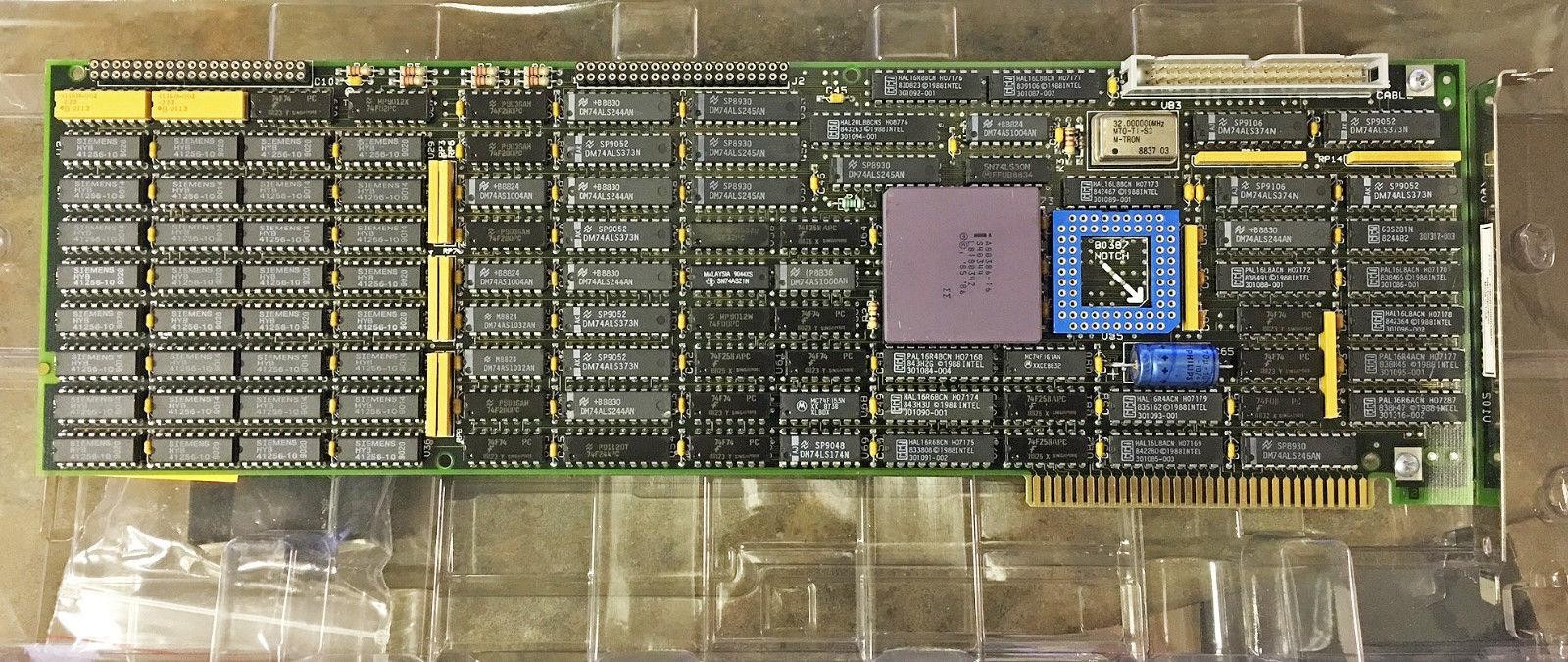 Inboard 386/PC Inboard 386/PC
Year: 1987
Interface: 8-bit ISA
New CPU: Intel 80386-16
Installed Memory: 1 MB
The Inboard 386/PC was designed to be installed in the original IBM Model 5150 PC or 5160 XT computers, as well as competing clones like the Compaq Portable and Portable Plus and the Tandy 1200 HD. On the card was an Intel 80386 CPU and 1 MB of memory (128 KB of this was reserved for the system BIOS).
Installation of the Inboard involved removal of the computer's existing 8088 CPU and 8087 FPU if fitted, and using the special supplied cable you would install one end of the cable into the CPU socket and the other into the Inboard expansion board. You also needed to set the DIP switches on the main motherboard to reduce the memory 'seen' by it to 256 KB (5160), 544 KB (unexpanded 5150), or 640 KB (expanded 5150).
Just like the Above Board range, the Inboard 386/PC supported the Intel "Piggyback" board to expand the onboard RAM by a further 2MB, offering 3 MB total system memory.
The Inboard 386/PC is not compatible with XT-class computers that use the Intel 8086 CPU such as the Compaq Deskpro or Amstrad PCs - only 8088 CPU-based computers.
|
 Inboard 386/AT Inboard 386/AT
Year: 1987
Interface: 16-bit ISA
New CPU: Intel 80386-16
Installed Memory: empty or 1 MB
Price When New: $1,995
(no RAM), $2,495 (1 MB RAM)
The Inboard 386/AT was designed to be installed in the original IBM Model 5150 PC or 5160 XT computers, as well as competing clones.
Intel dropped the price of the Inboard 386/AT in November 1987 to $1,599 with no RAM (down from $1,995), or $1,895 with 1 MB RAM installed (down from $2,495)
|
 Intel
Intel
 Intel's Above Board series were memory expansion cards for the IBM PC through to the IBM PC/AT. The original Model 5150 IBM Personal Computer came with only 128 KB of main memory. As time moved forward, software applications began to outgrow this, so customers had the need for more memory to run their software.
Intel's Above Board series were memory expansion cards for the IBM PC through to the IBM PC/AT. The original Model 5150 IBM Personal Computer came with only 128 KB of main memory. As time moved forward, software applications began to outgrow this, so customers had the need for more memory to run their software..jpg) At the time of the 80386's launch and for several years after, upgrading your PC was extremely expensive, since motherboards and CPUs weren't typically replaced by themselves as they are today - when a CPU upgrade was necessary, customers would purchase a whole new PC, possibly retaining any expansion cards they'd bought.
At the time of the 80386's launch and for several years after, upgrading your PC was extremely expensive, since motherboards and CPUs weren't typically replaced by themselves as they are today - when a CPU upgrade was necessary, customers would purchase a whole new PC, possibly retaining any expansion cards they'd bought.






